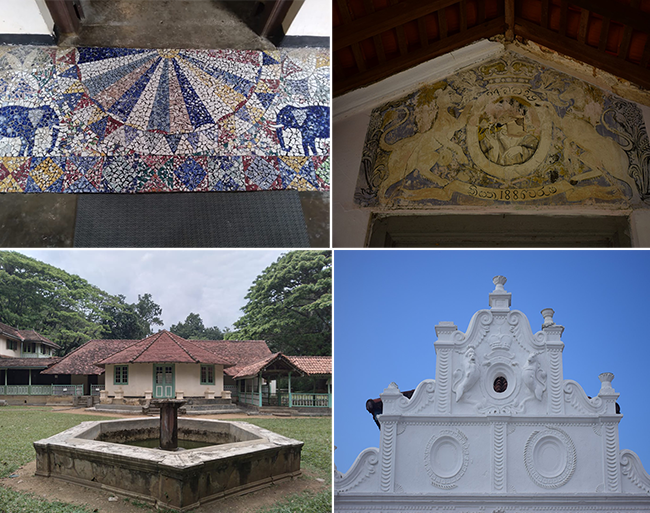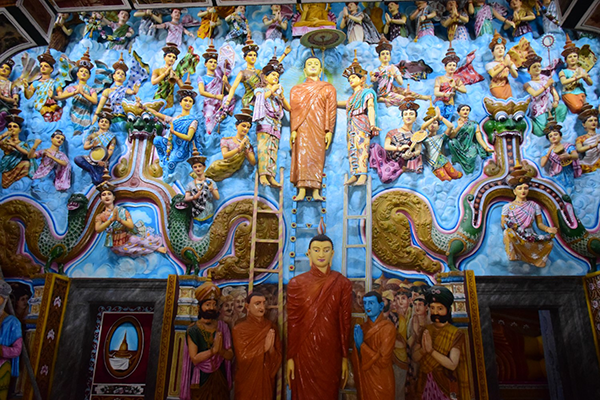Elite resistance to colonial rule : A continuing debate-By Uditha Devapriya
Source:-Island
The British takeover of the Kandyan Kingdom in 1815 led to a long period of resistance to colonial rule. Theoretically armed revolts against the British government ended in 1848, but popular expressions of resistance, couched more in symbols and propaganda than in armed insurrections, continued well into the mid-20th century. Having suppressed the traditional elite, to the extent of eradicating many of their families, the colonial government therefore chose to co-opt a section in it. The turning point was the 1848 rebellion, which alerted to officials the need to cultivate an intermediate class between the State and the masses. Their reasoning, essentially, was that lack of aristocratic authority had made the peasantry more amenable to insurrectionists and pretenders to the Kandyan Throne.
The traditional elites co-opted and appointed to positions such as the Ratemahattaya were different to the traditional elites that had been suppressed if not eliminated after the British annexation of Kandy. They hailed from a secondary layer, which had been subservient to the native chiefs. The process of their co-option worked out at three levels. Firstly, they were cultivated and lavishly patronised by the British government, in the form of land grants or knighthoods. Secondly, many of these families sent their children, who themselves followed their vocation, to elite English-medium schools, particularly those in Colombo, Galle, Kandy, and Jaffna. Thirdly, and perhaps most importantly, the British government more or less made government employment contingent on fealty to the British Crown and conversion to Anglicanism. The result was that a secondary elite that had been subservient to the Kandyan king and a number of chiefs shifted their loyalty to the British government.
A corollary of these shifts in official positions on the Kandyan aristocracy was a shift in attitudes to the social relations which had governed the Kandyan regions before the intrusion of colonialism. The British never abolished the institutions that had governed those relations: it was simply not in their interest to change them overnight. Yet, as Asoka Bandarage has noted in Colonialism in Sri Lanka, British officials were moved by a mixture of humanitarian ideals and self-interest to abolish some of the more oppressive features of those institutions, like caste. On these issues, the British governors themselves displayed little consistency: some were in favour of abolition, others were not. Ultimately, however, the 1848 rebellion led to a pivotal shift, to the extent that the State “perceived the threat posed by the erosion of aristocratic authority and took steps to restore it.”
Newton Gunasinghe has observed, correctly, that these policies prevented the emergence of a local bourgeoisie. Such developments instead benefitted an intermediate, subservient secondary elite, whose interests were in line with the British State, and who were hardly motivated to break up the social relations that they were now able to reassert, thanks to their newfound colonial patrons. Debates rage over the extent to which British colonialism implanted capitalism in Sri Lanka and the extent to which it prevented capitalism from emerging fully here. Yet as far as the growth of a secondary native elite is concerned, it is clear that colonial policies had the effect of stunting rather than encouraging the growth of capitalism. That was as true of the Kandyan regions as it was in the low country: in those regions, too, colonial policies benefitted either British officialdom or minority trade groups. Against such a backdrop, the native elites were hardly capitalist.
The role played by the native elites that were co-opted into the ranks of a subservient class remains controversial. This is so for two reasons. Firstly, if we take the adage that history never really happens, but is instead written and invented, then most accounts of the elite class that joined forces with the British are likely to be false, if not embellished. A corollary of this is that much of the popular literature on the elite families, in Sinhala, frames them as fervent opponents if not critics of colonialism, who used every proverbial trick in the book to subvert rather than advocate the policies of the British state, particularly in their regions. Secondly, and in my view more importantly, native elite interests may have been aligned with British colonial interests, but they were also, at one level, at variance with them. The character of this native elite class, and their relations with British colonialism, thus remains for me one of the more fascinating aspects of colonial history in Sri Lanka.
It goes without saying that relations between these two groups were fraught with contradictions. These stemmed, in part, from the quasi-feudal setup within which the co-opted elites operated: on the one hand they had to follow the orders of the colonial State, and on the other they had to maintain their leadership in their respective dissaves. The two goals did not always align with each other. Villagers would very often oppose colonial rule, particularly to taxation or corvee labour, while the headmen’s obligation was to the colonial State whose policies the villagers criticised and occasionally revolted against. The problem for the historian and anthropologist here is simple: given these contradictions, which side did the headmen take? Some would argue that they took the people’s side while declaring fealty to the British Crown, and others would argue they were unconditionally loyal to the latter. My contention is that it was possible, given the limits within which they worked, for headmen to be loyal both to the colonial State and to the people.
How so? The simplest answer is that it was in the British government’s own interest for village headmen to be seen as legitimate authority figures in their areas. The British had learnt, at an exorbitant cost, the consequences of subverting traditional authority during the 1848 rebellion. Subsequently, they set themselves to work in collaboration with the newly co-opted elite while promoting the (convenient) fiction that the latter’s duty to their people even surpassed their responsibility to the British State. For their part the elite realised the benefits of maintaining such a fiction: it helped them reinforce their authority in the villages, while carrying on good relations with British officialdom. Flipping this argument, we can hence say that popular expressions of anticolonial resistance forced the British government to use the elite classes, not to suppress people, but to make them pass off as legitimate representatives of the people. This task was arguably carried forward more discernibly in the highlands than in the Maritime Provinces, where 300 years of European colonialism had somewhat tempered the anticolonial tendencies of the people.
That said, it’s a little farfetched to draw a line between the low country and the up-country when it comes to popular and elite opposition to the British Crown. The same complexities can be discerned in both regions. Take the profusion of colonial symbols, like Dutch tiles and the portrait of Victoria, in the houses and residences of the native elites. Such symbols can be seen on the floors of Buddhist temples and the inner courtyard of at least one Sinhalese manor. Regarding the rationale for these symbols at temples, the head priest at Randombe Viharaya, in Ambalangoda, told me that people wished to express their resistance to British colonialism while perambulating the inner chamber and paying respects to the Buddha. The problem here is that such symbols adorn the entrances to these institutions as well. To this the Head Priest’s reply was that these temples were built with the aid of the British Crown, and that their founders wished to pay their respects to it. Note the logic: the symbols at the entrance, like Victoria’s portrait, denote loyalty to the British State, while the symbols along the floors in the inner sanctum denote repudiation of that same State.
The logic that dominates low country temples like the Randombe Viharaya dominates the residences of upcountry elites. I am of course talking about the Maduwanwela Walauwa here. At the inner courtyard of the Manor, one comes across, and invariably steps on, a tile bearing the portrait of the archetypal British monarch, Victoria. On the surface it suggests resistance to, and repudiation of, colonial authority. This version is more or less accepted by everyone, including the Archaeology Department: when I visited the Walauwa last year, the Department staff at the Walauwa carefully pointed out to me not just the image of Victoria on the floor, but also the Dutch tiles leading to the entrance, as evidence of his opposition of colonial rule. I am not in disagreement with such a thesis. On the other hand, though, we must note that these elites, if they wanted to maintain their position, had to be loyal to the colonial State and had to convert to Anglicanism. To be sure, they may have been nominal Christians, or “Rice Christians.” But that doesn’t resolve the paradox between loyalty to and repudiation of colonial authority which one comes across at the Walauwa.
One can argue either of two things here: that the Dissave was a lackey of the British Crown or that he played a double-game with the colonial State. I would agree with the latter view, but would also contend that there was no real contradiction between these two ideals, of fealty to the colonial State and fealty to the people. I would also contend that the so-called anticolonial symbols in the Walauwa are not anticolonial at all. They are what they are, tiles and mosaics bearing the dominant motifs of British rule, including a portrait of the British monarch. One can argue that stepping on them is hardly an act of reverence, but to a local, even a headman, stepping on them would hardly constitute disrespect, so long as these images have no religious, specifically Buddhist, connotations. Of course, Westerners may see things differently, but then the elites themselves probably did not: to them, placing the likeness of the British monarch, even on the floor, would have been reverential.
While the historical evidence we have may bear out these conclusions, however, it is more difficult to ascertain how the elite classes, and their families, themselves responded to these contradictions. As the sole, legitimate link between the State and the people, how did they see themselves? We know that they showed one face to colonial officials and another to their villagers. But in the great divide between these two groups – British officialdom and the indigenous peasantry – which side did they take? It is somewhat naïve to assume that they waited on the fence. Fundamentally, they were Anglicised and Westernised and they owed their careers, and their wherewithal, to the British Crown. But they were placed in such high positions by virtue of their ability to converse with their people, to handle their affairs and to represent them. It was a two-way street. Did they remain in the middle? The problem here is functional: us history writers are not psychoanalysts. We know how people behaved, but we have no idea about how they thought.
Perhaps the observation of a friend of mine can help us here: on his way out of the Maduwanwela Walauwa, he chortled to me that even if the anticolonial symbols inside were really anticolonial, “those officials could not possibly have minded them, I mean how could mere tiles pose a threat to the British Crown?” This is as insightful an interpretation as any I have heard, and it sits in with encounters between the Dissave and British officials: for instance, Herbert Wace, then Assistant Government Agent at Sabaragamuwa, is reported to have got on very well with him. Such encounters may baffle those who read into symbols like tiles and mosaics, but really, to me, the logic is simple: to the British Crown, superficial displays of resistance to the British Crowd did not matter in their larger scheme of co-opting and flattering the native elites – and keeping them in their payroll.
The writer is an international relations analyst, researcher, and columnist who can be reached at udakdev1@gmail.com.










